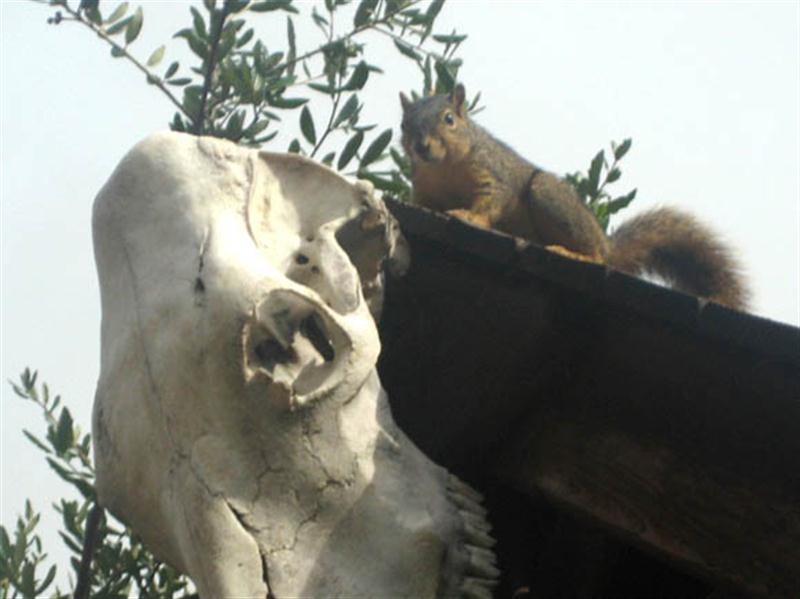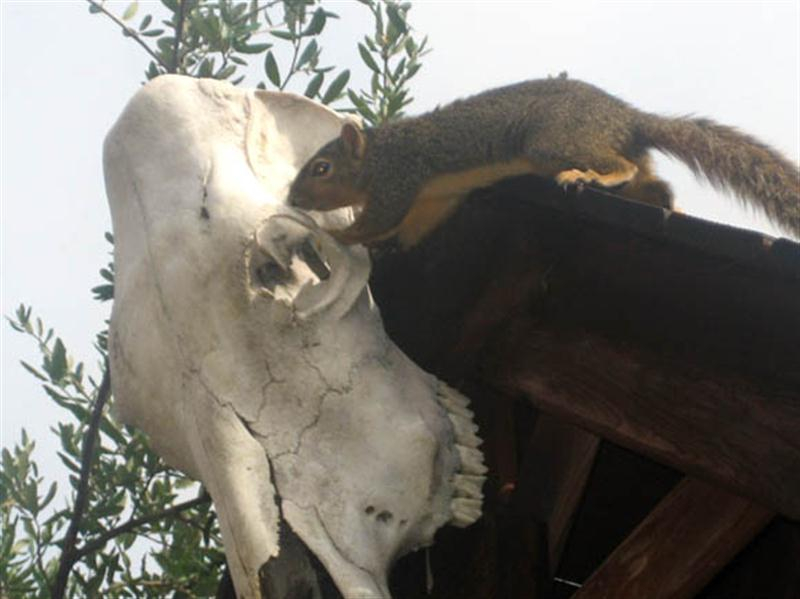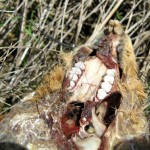Over the last several weeks this Fox Squirrel has shown an unusual interest in the cow skull mounted at the top of this structure. On several occasions we have caught the squirrel near the skull, only to have him quickly flee as we approached. Each time we would examine the skull looking for an explanation for the squirrel’s behavior, but no explanation was obvious.
With this series of photographs, the squirrel’s attraction to the cow skull is finally revealed.














What bizarre and fascinating behavior. Strangely picturesque, too.
Interesting photos, never seen anything like that before!
I can solve your mystery.! If an adult squirrel does not consume a minimum of 20 to 30mg of Calcium per day, or 150 to 210mg. per week, their body will leech calcium from their bones to supply the calcium they need for their rapidly growing incisor teeth.
If they continue to have a negative or non-existent supply of calcium, over a period of 4 to 6 months they will develop a condition called Metabolic Bone Disease. This slow developing condition becomes symptomatic overnight. They are fine one day, and the next they have lost the use of their back legs.
This weakness rapidly progresses to vomiting, seizures and ultimately death either from a fall that shatters their brittle, d-calcified bones, or cardiac arrest precipitated by the electrolyte imbalance created by the absence of calcium.
Many have mistakenly classified squirrels as omnivores because they have observed a squirrel chewing on a dead carcass or have seen them raiding a bird’s nest.
I contend that squirrels are predominant herbivores, yet, being rodents will resort to eating anything, even tar paper, in a starvation scenario. This observed behavior of chewing on dead carcasses, destroying eggs,( the shell of which is almost all calcium,) and even chewing on a dry skull by normal, healthy squirrels, is normal squirrel behavior in their daily search for calcium. And is a viable and more believable and logical explanation to this behavior!
Your dry skull also served a double purpose of supplying the calcium requirement, plus served as a gnawing block to keep the incisors wore down, which grow at an astonishing 1/2 to 3/4 inches per month in a healthy squirrel!
Just a side note: if you don’t want your squirrel gnawing on your skull, plant a bunch of Kale around the area. Kale is an excellent vegetable source of calcium, and is a hardy enough plant to winter over and even re grow the next summer.
William Sells
http://SquirrelNutrition.com
William, thank you for your insights! We have long suspected calcium was what was being sought, but had never really considered the constantly growing teeth as the prime motivator. We are very glad to have these squirrel chew on the skull as much as they would like. This particular skull is now open on the top ,with almost two inches of the crown gone to gnawing!
-Chris
Is there something we can spray on the bone to keep the squirrels from chewing on it? Perhaps clear sealant?